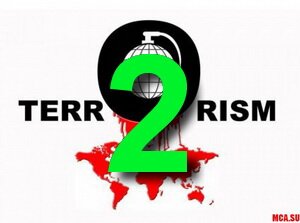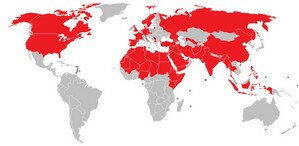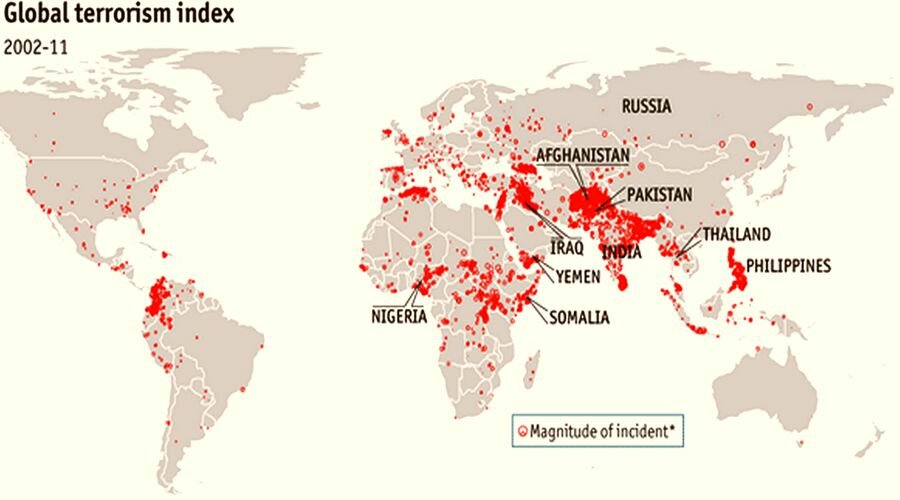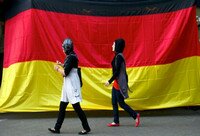
Part 2: Islamic terrorism
Islamist terrorism is the tactics to eliminate opponents by violence, finding itself an ideological justification and excuse in interpretations of the religious doctrine as aimed at protecting “the Islamic world against the influence or aggression of non-Muslim countries and ideologies, especially of the Western world.”
 At the moment it is the most common (in the number of manifestations) form of terrorism. It is usually used by radical, extremist organizations. Members of such organizations are called Islamists or Islamist militants. To justify their tactics, they refer to the prescribed to the faithful duty to wage jihad, although many Muslim theologians and religious scholars question the interpretation of this duty as a need in physical violence.
At the moment it is the most common (in the number of manifestations) form of terrorism. It is usually used by radical, extremist organizations. Members of such organizations are called Islamists or Islamist militants. To justify their tactics, they refer to the prescribed to the faithful duty to wage jihad, although many Muslim theologians and religious scholars question the interpretation of this duty as a need in physical violence.
The Quran reads: “Make ready against them as much force as you can, including steeds to threaten the enemy of Allah and your enemy, and others besides them, whom you do not know, but whom Allah knows. Whatever you spend in Allah's way, will be returned to you in full, and you will not be dealt with unjustly.”
In the Muslim community, the attitude towards terrorism is ambiguous. On the one hand, there is non-acceptance of the term and accusations of terrorism against the “enemy” political parties. On the other hand, a significant part of radical Muslims supports the policy of terror and waging a “jihad” against infidels.
Experts on Islam believe that Islamist terrorism is one of the variants of religious terrorism. Its characteristic feature is condonation of the killing of civilians, of women and children included, as they are considered an integral part of the enemy: they finance the army through paying taxes, supporting it with “their silence and acquiescence” and they are potential soldiers. It is also believed that the main reasons for the emergence of Islamic terrorism was the desire to save the traditional Muslim social structure from the rapid decay in a close contact with social and cultural values of the Western civilization.
Especially sharp was the Muslim world's reaction to the new wave of scientific and technological revolution, not without reason, for fear that introduction on a national basis of the European way of life will inevitably lead to the disintegration of the traditional Muslim society, destruction of its moral and ethical basis, to the loss of national identity.
At the moment, Islamist terrorism is not a single structure, controlled from a single center. Separate groups exist and operate independently, and often are not associated with each other. There are locally regional Islamist groups and transnational terrorist networks. Ideological affinity and even direct contacts do not turn local groups into branches of global jihad, their goals differ significantly. Each of these two levels of Islamic terrorism is trying to maintain a significant degree of its autonomy, its own dynamics and logic of development.
 |
|
Countries, which have been attacked by Islamist terrorists since September 11, 2001 https://commons.wikimedia.org/ |
Highlighted in red are countries attacked by Islamist terrorists since September 11, 2001. According to the CIA, the vast majority of terrorist organizations in the world are related to Islamism. For example, back in 2004 out of 80 international terrorist organizations, 72 were representing militant Islam. In the same year, they made 651 terrorist attacks, which killed 1.907 people.
In Europe, only a small part of terror attacks is committed by hands of Islamists. Thus, in 2010 they committed three terrorist acts out of 249. In majority of the attacks are involved various radical groups of the right or left wing and all sorts of separatists.
Radicalization of Islamic youth or Islamization of radical youth in Europe?
For various reasons, it is difficult to determine the threat of Islamic extremism in Europe. Even the real number of Muslims living in Europe, is not known. For example, in France, different sources state that living there are not four, but five, or maybe even 6 million Muslims.
Below is a summary table of the estimated Muslim population in Europe.
|
Country |
Total population |
Muslims |
Percentage of Muslims to total population |
|
Austria |
8.102.600 |
300.000 |
3.7 |
|
Belgium |
10.192.240 |
370.000 |
3.6 |
|
UK |
55.000.000 |
1.406.000 |
2.6 |
|
Germany |
82.000.000 |
about 4.500.000 |
5.4 |
|
Greece |
10.000.000 |
370.000 |
3.7 |
|
Denmark |
5.330.020 |
150.000 |
2.8 |
|
Spain |
40.202.160 |
300.000-400.000 |
0.7-1 |
|
Italy |
56.778.031 |
700.000 |
1.2 |
|
Netherlands |
15.760.225 |
695.600 |
4.4 |
|
Portugal |
9.853.000 |
30.000-38.000 |
0.3-0.4 |
|
France |
56.000.000 |
4.000.000-5.000.000 |
7.1-8.9 |
|
Sweden |
8.876.611 |
250.000-300.000 |
2.8 |
But, without a doubt, today it can be stated that the problem is very real and is a threat:
- before 2000 demonstrations of Islamists in the streets of European cities were rare. After September 11, 2001 has been marked the growth of such demonstrations in France and Belgium. Thousands of people took to the streets in early 2004 in Paris to protest against the ban on wearing the hijab in public schools;
- ten years ago hijabs were mostly worn by elderly women. Now they are worn by at least half of the female Muslim population. In some municipalities of France, the figure is 80%;
- in most cases, Muslim girls and women do not take an independent decision to wear the hijab. But they had to do it under pressure from the family or the Muslim community. In some European cities, a Muslim girl, who does not agree to wear a hijab, risks being subjected to harassment, physical violence, sexual abuse and even collective rape. In France, for example, these acts of aggression occur regularly;
 |
|
According to the law adopted in 2011, for wearing a niqab or burqa in public places in France the fine is up to 150 Euros |
- till the end of 1990s, Islamist radical organizations were small in number and existed only in some European countries. Now they can be found in almost all European countries, especially in France and Belgium. They are already quite large and want to be represented in parliaments. It is appropriate to mention Belgium as an example, where in May 2003 “Parti de la Citoyennete et Prosperite” (“The party of citizenship and prosperity”, PCP), defending radical Islam, got in Brussels more than 8 thousand votes. If we take into consideration that the capital of Belgium is home to about 200 thousand Muslims, it means that about 4% of Muslims voted for it. If we don't count those who cannot vote due to their age, this percentage will be even more impressive. Moreover, the majority of the votes was got in the municipality where live about 50 thousand Muslims, which means that 10% to 16% of Muslims submitted voted for the party that protects radical Islam! There is something to think about;
- the Police and Intelligence Services have information that fundamentalism and prayers of hatred are common in most mosques;
- youth associations, acting as a cover for the organization “Muslim Brotherhood”, are extremely popular and rapidly increasing;
- since 2000, the number of anti-Semitic acts has increased dramatically. Over the past four years have been recorded hundreds of acts of aggression carried out by Muslim youth;
- in schools attended by Muslim children, it becomes more and more difficult to teach certain subjects and themes. For example, it is impossible to teach the history of the Holocaust. In biology class, boys and girls openly question the theory of the origin of life, the evolution of species and of humanity;
- in the same schools is more and more often observed a de facto sexual segregation. For example, often the boys sit in one part of the classroom, and the girls — in the other;
- in hospitals, are very frequent cases when women refuse to treat men or men refuse to treat women;
- Islamist presence in European prisons where Muslims are often the majority, now can be observed in many European countries;
- after 11 September 2001, hundreds of terrorist suspects have been arrested in Europe (France, Belgium, Germany, UK, Italy, Spain, the Netherlands, etc.). However, the Police arrests more and more terrorist suspects. This shows that the number of people moving from ideas of Islamism to actions is increasing rapidly;
- hundreds of young Muslims have been recruited since summer of 2003 and sent to fight in Iraq.

|
|
Places and frequency of terrorist acts in the world http://ultraprogress.ru/ |
Unfortunately, the exact scale of the threat is still difficult to determine. The French internal intelligence service — les Renseignements Generaux — made the approximate formula which determines the ratio of Islamic fundamentalists to the total number of the Muslim population. Based on extensive research on French soil, the formula is as follows: usually among the Muslim population about 5% are fundamentalists. Three percent out of these 5% are potentially dangerous. This means that if in France live 6 million Muslims, we have 300 thousand fundamentalists, of which 9000 are potentially dangerous.
At present, the most explosive countries of Western Europe are considered to be France, Belgium, Netherlands, Italy, Spain, UK and Germany.
Outside the European Union, a big threat comes from Bosnia. Obviously, in these countries, we find the highest number of Muslims. This does not mean, of course, that the average Muslim population is fundamentalist or dangerous. Most Muslims, even if the trend of returning to the religion is clear and massive, tend to a normal life. But, of course, the presence of a large Muslim Ummah suggests the best statistical possibility for the recruitment, and more places to hide. But the countries that do not have a large Muslim community, are not in safety at all. For example, in Slovakia, where there is virtually no Muslim population, at the University of Bratislava there appeared cells for propaganda and funding Hezbollah.
|
Note: Islamist organizations whose cells operate in European countries:
|
Three generations — three mentalities, or the progressing fear factor
Up to the last decade, the policy of European states towards Muslim communities was limited to recognition of Islam at the constitutional level and ensuring conditions for financial and political independence of their members. Analysis of the current situation in Europe shows that such a solution to the problem of multiculturalism and adaptation of the Muslim population has led to its deliberate segregation. Moreover, in the process of quantitative growth, Muslim communities have moved from a passive strategy of autarky to an active autarky. Today we have to talk about three generations of Muslims in Europe, and only the older generation demonstrates sufficient loyalty to the host country.
To the first generation belong economic migrants who arrived in the 1960s on the wave of decolonization. To date, their age is about 60 years. It may be noted that they have quite successfully passed adaptation and very well have overcome the first symptoms of culture shock because the very move to another country was perceived as a way to change their own status for the better. It is significant that the unrest of fall 2005, in the suburbs of Paris did not spread to such countries of new immigration as Spain or Italy. Living on their territory, young immigrants from Morocco took no active steps in connection with the French events mainly due to the fact that they are a relatively new immigrant group, and as the first generation of immigration do not claim to benefits which European countries give to their indigenous inhabitants.
The second generation of European Muslims is children of labor migrants who first arrived at an early age, or even were born and brought up in the new to them conditions. They are now 30-40 years old. If their parents were grateful to the host side for the very admission to the Western consumer society, their children have seen a clear limitation of their opportunities, compared with Western age-mates, which fact could not fail to cause some reaction.
To the third generation belong grandchildren of first immigrants, born, brought up and educated in Europe, who are citizens of European states. Having gone through European educational institutions, daily being exposed to European media, they had to get into the spirit of secular Christian-Jewish civilization of the West. However, studies state the opposite: this desire for radical extremism, hyper perception of feelings of certain injustice and of belonging to the ummah.
Despite the best efforts of social institutions such as schools, media, etc., to talk about the coincidence of the cultural code of the representatives of Western society and Muslim communities, is clearly premature. While expectations of the second and third generations of immigrants are much higher than their actual capabilities of self-realization, which leads to the overall aggressiveness of young Muslims and prevents their full integration into a modern European society. They are looking for answers to their questions in the familiar and close to them ummah.
 |
|
Radicalization of Islamic youth is due to the Internet |
Enhancement of radicalization of Islam adherents at the age of 16 to 24 — compared with their parents — was found out by the study conducted by the analytical agency Populusby order of the public organization Policy Exchange, close to the Conservative Party of Britain.
According to the survey, nearly one-third of the 320 thousand young Muslims consider it necessary to introduce Sharia law in the British Isles. Such views in the age group over 55 are expressed by only 17%. At this, 84% of respondents said that the attitude to them in Great Britain is tolerable.
A Muslim who converted to some other religion should be punished with death, said 36% of the young pollees. Muslims of the older age, who share such radical views, make about 19%.
Most clearly the difference in the views of the grandchildren, children and parents was shown in the attitude to the hijab. 74% of young Muslims prefer women to wear the hijab. Among the older generation, such view is shared by 28%.
13% of young Muslims said they admired organizations such as al-Qaeda — as compared with 3% in the age group over 55.
58% of all respondents believe that many of the world's problems are the result of the “blatant Western policy”. At this, awareness of the respondents about what is happening in the world is poor: only one in five knows that Mahmoud Abbas is the President of the Palestinian Autonomy.
Results of the survey of 1003 representatives of the Muslim community allowed the researchers to state, “there is a conflict in the British Islam — between the moderate majority who accepts the norms of Western democracy and the growing aggressive radical minority”.
Internal stratification of Muslim communities by age and ethnic indicators does not allow to reduce the current situation at the present stage to the primitive formula “Muslims of Europe = violence + rejection of integration”. In the eyes of the indigenous population, they all are perceived as Muslims in general. As immigrants, representatives of African and Asian communities form a quasi-ethnic group, the core of which is Islam. Besides, the researchers concluded that within the diaspora ethnic and fellowcountryman affiliation is more important than the confessional one.
Let's take a closer look at this situation in some countries.
According to various estimates, in Germany, there live up to four and a half million Muslims. More than 40 thousand of them are radical Islamists. They raise funds for the war in Iraq and Syria, recruit and send volunteers. The most famous of them is Berlin rapper Deso Dogg, who converted to Islam and is now called Abu Talha al-Almani who was killed in Syria last spring. Many volunteers from Germany fought in the group “The German Brigade Millatu Ibrahim”.
 |
|
German Muslims have long since become full members of society http://wordyou.ru/ |
Volunteers from Germany are fighting in Afghanistan. There exists a group called the “German Taliban Mujahideen” there, whose leader was Eric Breininger, who died this year during clashes with Pakistani security forces in Waziristan. It is estimated that in Afghanistan, there are dozens of ethnic Germans who embraced Islam and are fighting on the side of the Taliban.
Among the fighters are mainly those who had converted to Islam and identifies him/her/self with the Salafis. But what makes the German youth grow long beards and go to fight in a foreign country, adhering to the medieval laws? Young, brave, poorly educated, who grew up in a troubled family — such is often a portrait of a militant Salafi, says a researcher of Islam at Osnabrück University Michael Kiefer.
But in order to have radicalized youth, should probably work together several factors. “When in a difficult situation, young people meet someone who shows respect for them, creates a sense of camaraderie and tells them what to do, it can turn into a tragedy,” — said Keifer in his interview to Hessischer Rundfunk.
According to the German secret services, at least 270 radical Islamists from Germany have fought in Syria this year. Now some of them are fighting in Iraq as part of units of the Islamic State, part of them has returned home, to Germany. We are talking about approximately a hundred jihadists with real combat experience and the desire to fight.
“Today it is not the problem of the Germans alone. It is a common problem of Europe. Two and a half thousand people from the European Union have left for the jihad”, — said the Minister of Internal Affairs of the Federal State of North Rhine-Westphalia Ralph Yeager.
In summer, German counterintelligence informed about the danger of terrorist attacks in the country. Now this danger has only grown. Jihadists may want to take revenge for the fact that Berlin has decided to support with weapons the Iraqi Kurds in their struggle against the IS.
|
ВIn Wuppertal began to work “sharia police”. Proponents of conservative Islam, Salafis, go out into the streets, patrol night clubs, bars, catch in the street drunk citizens of different faiths and conduct educational work with them, offering to give up alcohol, smoking, as well as to adhere to the canonical norms of behavior in Islam |
Video, laid out a couple of months ago on the Internet, just shocked both, native Germans and some Muslims from the first generation of immigrants. We mean patrolling the streets of the German town of Wuppertal by bearded young people in special orange vests with the sign “sharia police”. So far, it is limited to only explanatory conversations, but Police believe that among those patrols can be radical Islamists.
To be continued

